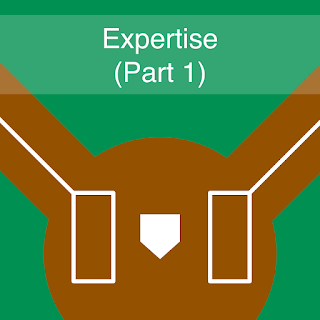Editorial Note: This is the second installment of The Downside of Expertise. In Part 1, we introduced the idea that experts can get stuck in a rut. They have a hard time ignoring their expertise when it comes to things riding a bike, swinging at a pitch, or generating creative solutions to a problem. In Part 2, we explore how this line of research got started, and how it might connect to education. Go find your chessboard, and we'll get started!
Check and Mate!
 |
| Chessboard A |
 |
| Chessboard B |
Now that we've determined which board is which, what if I asked you to memorize the configuration of the pieces on the board? Do you think you could do it? How long would you have to study the board until you memorized all of the pieces? How many pieces do you think you could get right after studying the board for one minute?
Let's up the ante one more time. Suppose that we pitted your board memorization skills against a chess master. Amazingly, a master can reproduce an entire chessboard in about 5 seconds [2]. In a controlled laboratory experiment, scientists compared asked a chess master, a class A player, and a chess novice to memorize a mid-game or randomly scattered board [3]. For a mid-game board, the chess master was able to remember more pieces than either the class A player or the novice. He was able to memorize the spatial configuration of approximately 25 pieces because he was able to chunk them into higher-level patterns of positions one might expect during a chess game. Given what we know about well-developed retrieval structures, the master's performance comes as no surprise.
But how did the chess expert fair with the random board? As it turns out, his performance was reduced to a novice, despite the fact that he had an extremely elaborate schema for chess positions. Because the positions didn't make any sense in the random configuration, he was forced to fall back to brute-force memorization, which carries with it all of the standard limitations of working memory. In fact, the novice slightly outperformed him!
The same principle of expertise holds for chess masters and Major League Baseball batters: Expertise is highly narrow. Once you depart from the patterns that experts expect, they perform at novice levels.
The STEM Connection
There are definite downsides to expertise when the situation completely violates an expert's deeply engrained schema or mental model. But what, if any, are the downsides for education? A master teacher is an expert in a particular content area (e.g., how to solve algebraic problems) and owns a vast repertoire of pedagogical content knowledge (e.g., how to teach algebra).
Like the creativity study, can content knowledge get in the way of teaching? One way that it might be harmful is when teachers forget what it is like not to know something. Or, stated differently, experts might not remember the developmental sequence that a student must undergo when learning something new. When this forgetting takes place, educational researchers call it the expert blindspot.
In a series of studies [4-6], Mitch Nathan and his collaborators demonstrated the conditions under which expert teachers are blinded by their expertise. They asked teachers with different levels of content knowledge to rank-order six math problems that varied along two dimensions. For the first dimension, the unknown (x) was placed either at the beginning (e.g., x • a + b = c) or the end (e.g., [c - b]/a = x) of the problem. The start-unknown problems were essentially algebraic problems because the student had to apply the inverse of the operators to compute the unknown value. The end-unknown problems were essentially arithmetic problems because they could be solved by applying each operator in the prescribed order.
For the second dimension, problems were stated either symbolically (e.g., x • 6 + 66 = 81.90), as a word equation (e.g., "Starting with some number, if I multiply it by 6 and then add 66, I get 81.90. What did I start with?"), or as a story problem (e.g., "When Ted got home from his waiter job, he multiplied his hourly wage by the 6 hours he worked that day. Then he added the $66 he made in tips and found he earned $81.90. How much per hour did Ted make?"). Take a moment to figure out which problems you think are the most difficult:
All teachers agreed that the end-unknown problems were easy because they basically tell the student what to do. The surprising result was that students found the verbal problems (i.e., the story problem and word equation) to be easier than the symbolic equation for the start-unknown problems. The reason why is that the format of these problems prompted students to fall back onto various problem-solving patterns that were logic-based. In other words, students have been reasoning verbally for much longer than they have symbolically, and this became evident when they were faced with challenging, algebraic problems. Like the creativity study, can content knowledge get in the way of teaching? One way that it might be harmful is when teachers forget what it is like not to know something. Or, stated differently, experts might not remember the developmental sequence that a student must undergo when learning something new. When this forgetting takes place, educational researchers call it the expert blindspot.
In a series of studies [4-6], Mitch Nathan and his collaborators demonstrated the conditions under which expert teachers are blinded by their expertise. They asked teachers with different levels of content knowledge to rank-order six math problems that varied along two dimensions. For the first dimension, the unknown (x) was placed either at the beginning (e.g., x • a + b = c) or the end (e.g., [c - b]/a = x) of the problem. The start-unknown problems were essentially algebraic problems because the student had to apply the inverse of the operators to compute the unknown value. The end-unknown problems were essentially arithmetic problems because they could be solved by applying each operator in the prescribed order.
For the second dimension, problems were stated either symbolically (e.g., x • 6 + 66 = 81.90), as a word equation (e.g., "Starting with some number, if I multiply it by 6 and then add 66, I get 81.90. What did I start with?"), or as a story problem (e.g., "When Ted got home from his waiter job, he multiplied his hourly wage by the 6 hours he worked that day. Then he added the $66 he made in tips and found he earned $81.90. How much per hour did Ted make?"). Take a moment to figure out which problems you think are the most difficult:
- Start-unknown; story problem
- Start-unknown; word equation
- Start-unknown; symbolic equation
- End-unknown; story problem
- End-unknown; word equation
- End-unknown; symbolic equation
Expertise is typically a great thing to aspire to, and I highly recommend it. So I don't want to give the impression that you should avoid becoming an expert. But I do want to make explicit some of the misconceptions that people might have about what experts can and can't do. As the authors of Freakonomics are fond of saying, there's a "hidden side to everything" [7]. For expertise, the hidden side is a difficulty in suppressing one's own expertise.
Share and Enjoy!
Dr. Bob
For More Information
[1] Chessboard A is an actual mid-game; whereas Chessboard B is a random assortment of pieces. There are multiple ways to figure it out, but one piece of evidence is that there are two black bishops on the same colored squares, which can never happen in an actual game.[2] de Groot, A. D. Thought and choice in chess. The Hague: Mouton, 1965.
[3] Chase, W. G., & Simon, H. A. (1973). Perception in chess. Cognitive psychology, 4(1), 55-81.
[4] Nathan, M. J., & Koedinger, K. R. (2000). An investigation of teachers' beliefs of students' algebra development. Cognition and Instruction, 18(2), 209-237.
[5] Nathan, M. J., & Koedinger, K. R. (2000). Teachers' and researchers' beliefs about the development of algebraic reasoning. Journal for Research in Mathematics Education, 168-190.
[6] Nathan, M. J., & Petrosino, A. (2003). Expert blind spot among preservice teachers. American Educational Research Journal, 40(4), 905-928.
[7] Dubner, S. J., & Levitt, S. D. (2010). Freakonomics: A Rogue Economist Explores the Hidden Side of Everything. HarperCollins.







